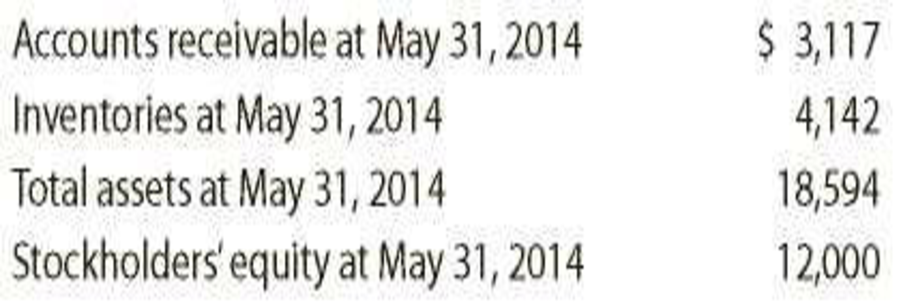
Financial statement analysis
The financial statements for Nike, Inc., are presented in Appendix D at the end of the text. Use the following additional information (in thousands):

Instructions
- 1. Determine the following measures for the fiscal years ended May 31, 2016, and May 31, 2015. Round ratios and percentages to one decimal place.
- a.
Working capital - b.
Current ratio - c. Quick ratio
- d.
Accounts receivable turnover - e. Number of days’ sales in receivables
- f. Inventory turnover
- g. Number of days’ sales in inventory
- h. Ratio of liabilities to stockholders’ equity
- i. Asset turnover
- j. Return on total assets.
- k. Return on common stockholders’ equity
- l. Price-earnings ratio, assuming that the market price was $54.90 per share on May 29, 2016, and $52.81 per share on May 30, 2015
- m. Percentage relationship of net income to sales
- a.
- 2. What conclusions can be drawn from these analyses?
1.
Determine the following ratios for the fiscal years ended May 31, 2016 and May 31, 2015:
- (a) Working capital
- (b) Current ratio
- (c) Quick ratio
- (d) Accounts receivable turnover ratio
- (e) Number of days’ sales in receivables
- (f) Inventory turnover ratio
- (g) Number of days’ sales in inventory
- (h) Ratio of liabilities to stockholders’ equity
- (i) Asset turnover ratio
- (j) Return on total assets
- (k) Return on common stockholders’ equity
- (l) Price-earnings ratio
- (m) Percentage relationship of net income to sales
Explanation of Solution
Financial Ratios: Financial ratios are the metrics used to evaluate the liquidity, capabilities, profitability, and overall performance of a company.
(a)
Working capital is determined as the difference between current assets and current liabilities.
Formula:
Calculate working capital for May 31, 2015 and May 31, 2016.
Thus, working capital for 2016 and 2015 is $9,667.0 and $9,255.0
b)
Current ratio is used to determine the relationship between current assets and current liabilities. The ideal current ratio is 2:1. Current assets include cash and cash equivalents, short-term investments, net, accounts and notes receivables, net, inventories, and prepaid expenses and other current assets. Current liabilities include short-term obligations and accounts payable.
Formula:
Current ratio for 2016 and 2015
Thus, current ratio for 2016 and 2015 is 2.8 and 2.5
c)
Acid-Test Ratio is the ratio denotes that this ratio is a more rigorous test of solvency than the current ratio. It is determined by dividing quick assets and current liabilities. The acceptable acid-test ratio is 0.90 to 1.00. Use the following formula to determine the acid-test ratio:
Acid-test ratio for 2016
Working notes:
Quick Assets are those assets that are most liquid. The examples of quick assets include cash and bank balances, marketable securities, and sundry debtors. Use the following formula to determine the Quick assets:
Hence, quick ratio for 2016 and 2015 are 1.6 and 1.5 respectively.
d)
Accounts receivable turnover ratio for 2016 and 2015
Description:
Accounts receivables turnover ratio is mainly used to evaluate the collection process efficiency. It helps the company to know the number of times the accounts receivable is collected in a particular time period. Main purpose of accounts receivable turnover ratio is to manage the working capital of the company. This ratio is determined by dividing credit sales and sales return.
Formula:
Average accounts receivable, net for 2016 and 2015 is determined as follows:
Hence, the accounts receivable turnover ratio for 2016 and 2015 is 9.8 times and 9.5 times.
e)
Number of days’ sales in receivables for 2016 and 2015
Description:
Number of days’ sales in receivables is used to determine the number of days a particular company takes to collect accounts receivables.
Formula:
Average daily sales are determined by dividing sales by 365 days. Average accounts receivables for 2016 and 2015 are determined in previous requirement. Thus, average daily sales for 2016 and 2015 are determined as follows:
Hence, the number of days’ sales in receivable for 2016 and 2015 are 9.8 days and 9.5 days respectively.
f)
Inventory turnover ratio for 2016 and 2015
Description:
Inventory turnover ratio is used to determine the number of times inventory used or sold during the particular accounting period.
Formula:
Average inventory for 2016 and 2015 is determined as below:
Hence, the inventory turnover ratio for 2016and 2015 is 3.8 and 4.0 respectively.
g)
Number of days sales in inventory for 2016 and 2015
Description:
Number of days’ sales in inventory is determined as the number of days a particular company takes to make sales of the inventory available with them.
Formula:
Average daily cost of goods sold are determined by dividing cost of goods sold by 365 days. Thus, average daily cost of goods sold are determined as follows:
Hence, the number of days’ sales in inventory for 2016 and 2015 are 96.2 days and 91.4 days respectively.
h)
Ratio of liabilities to stockholders’ equity for 2016 and 2015.
Description:
Ratio of liabilities to stockholders’ equity is determined by dividing liabilities and stockholders’ equity.
Formula:
Hence, the ratio of liabilities to stockholders’ equity for 2016 and 2015 is 0.7.
i)
Asset turnover ratio for 2016 and 2015
Description:
Asset turnover ratio is used to determine the asset’s efficiency towards sales.
Formula:
Working notes for average total assets for 2016 and 2015 are as follows:
Hence, asset turnover ratio for 2016 and 2015 is 1.5.
j)
Return on total assets for 2016 and 2015
Description:
Return on assets determines the particular company’s overall earning power. It is determined by dividing sum of net income and interest expense and average total assets.
Formula:
Hence, rate of return on assets for 2016 and 2015 are 17.6% and 16.4% respectively.
k)
Return on common stockholders’ equity for 2016 and 2015
Description:
Rate of return on stockholders’ equity is used to determine the relationship between the net income and the average common equity that are invested in the company.
Formula:
Average stockholders’ equity is determined as follows:
Hence, rate of return on stockholders’ equity for 2016 and 2015 are 30.1% and 26.5% respectively.
l)
Price earnings ratio for 2016 and 2015
Description:
Price/earnings ratio is used to determine the profitability of a company. This ratio is abbreviated as P/E.
Formula:
Hence, the calculated price-earnings ratio for 2016 and 2015 is 24.8 and 28.5 respectively.
m)
Net income to sales for 2016 and 2015
Description:
Net income to sales is determined by dividing net income to sales.
Formula:
Thus, summary table of determined ratios are below:
| Particulars | 2016 | 2015 |
| $9,667.0 | $9,255.0 |
| 2.8 | 2.5 |
| 1.6 | 1.5 |
| 9.8 | 9.5 |
| 37.2 days | 38.6 days |
| 3.8 times | 4.0 times |
| 96.2 days | 91.4 days |
| 0.7 | 0.7 |
| 1.5 | 1.5 |
| 17.6% | 16.4% |
| 30.1% | 26.5% |
| 24.8 times | 28.5 times |
| 11.6% | 10.7% |
2.
Draw conclusion about the analysis made in requirement 1.
Explanation of Solution
- The working capital ratio has increased in the year 2016 when compared with 2015.
- The current ratio and quick ratio of the company have increased during the year 2016.
- The accounts receivable turnover ratio and number of days’ sales in receivables have increased in the year 2016. But, whereas, number of days’ sales receivables have decreased slightly. Thus, here, company takes over one month to collect the accounts receivables from credit sales.
- Inventory turnover ratio and number of days’ sales in inventory is increased and it is critical for the company. Thus, it shows a favorable change.
- Creditor’s protection remained constant and thus, it is very sound from the ratio of liabilities to stockholders’ equity.
- Asset turnover ratio indicates assets were used effectively towards generation of revenues for both the years.
- Return on total assets has increased during the year 2016. Net income has increased.
- Return on common stockholders’ equity has increased and it has strong earnings performance in the year 2016.
- The price-earnings ratio has decreased in the year 2016.
- The percentage of net income to sales has increased during 2016.
Want to see more full solutions like this?
Chapter 17 Solutions
Financial Accounting
- The average net profits expected in the future by Khalifa and Co. are RO. 30,000 per year. The average capital employed in the business by the firm is RO. 200,000. The normal rate of return on the capital employed in a similar business is 10%. Calculate goodwill of the firm by: 1. Super Profit Method on the basis of two-year purchase. 2. Capitalization Method.arrow_forwardWhat will it's net income be?arrow_forwardThe total direct labor variance isarrow_forward
- General accounting questionarrow_forwardMCQarrow_forwardSproles Inc. manufactures a variety of products. Variable costing net operating income was $148,000 last year and its inventory decreased by 3,980 units. Fixed manufacturing overhead cost was $12 per unit. What was the absorption costing net operating income last year? a. $47,760 b. $148,000 c. $100,240 d. $195,760arrow_forward
- Garner Grocers began operations in 2005. Garner has reported the following levels of taxable income (EBT) over the past several years. The corporate tax rate was 34% each year. Assume that the company has taken full advantage of the Tax Code's carry-back, carry- forward provisions, and assume that the current provisions were applicable in 2005. What is the amount of taxes the company paid in 2008? Year Taxable Income 2005-$3,200,000 2006 $200,000 2007 $500,000 2008 $2,800,00 a. $92,055 b. $96,900 c. $102,000 d. $107,100 e. $112,455arrow_forward??!!arrow_forwardHow much gain will Harper recognize on these accounting question?arrow_forward
 Financial AccountingAccountingISBN:9781337272124Author:Carl Warren, James M. Reeve, Jonathan DuchacPublisher:Cengage Learning
Financial AccountingAccountingISBN:9781337272124Author:Carl Warren, James M. Reeve, Jonathan DuchacPublisher:Cengage Learning Financial AccountingAccountingISBN:9781305088436Author:Carl Warren, Jim Reeve, Jonathan DuchacPublisher:Cengage Learning
Financial AccountingAccountingISBN:9781305088436Author:Carl Warren, Jim Reeve, Jonathan DuchacPublisher:Cengage Learning Financial And Managerial AccountingAccountingISBN:9781337902663Author:WARREN, Carl S.Publisher:Cengage Learning,
Financial And Managerial AccountingAccountingISBN:9781337902663Author:WARREN, Carl S.Publisher:Cengage Learning, Managerial AccountingAccountingISBN:9781337912020Author:Carl Warren, Ph.d. Cma William B. TaylerPublisher:South-Western College Pub
Managerial AccountingAccountingISBN:9781337912020Author:Carl Warren, Ph.d. Cma William B. TaylerPublisher:South-Western College Pub Managerial Accounting: The Cornerstone of Busines...AccountingISBN:9781337115773Author:Maryanne M. Mowen, Don R. Hansen, Dan L. HeitgerPublisher:Cengage LearningPrinciples of Accounting Volume 1AccountingISBN:9781947172685Author:OpenStaxPublisher:OpenStax College
Managerial Accounting: The Cornerstone of Busines...AccountingISBN:9781337115773Author:Maryanne M. Mowen, Don R. Hansen, Dan L. HeitgerPublisher:Cengage LearningPrinciples of Accounting Volume 1AccountingISBN:9781947172685Author:OpenStaxPublisher:OpenStax College





